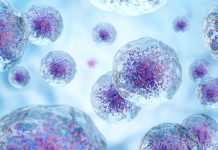Dr Alice Di Pasquale, Scientific Research Officer at Breast Cancer UK, explains why more must be done to increase awareness of Endocrine Disrupting Chemicals and breast cancer risk
Breast cancer is the most common cancer worldwide. In the UK, around 56,000 women and 400 men are diagnosed every year. (1) It is estimated that one in seven women (born after 1960) will develop breast cancer in their lifetime. Whilst some breast cancer risk factors are non-modifiable (for example, age, genetic mutations, sex and family history), at Breast Cancer UK, our research suggests that at least 30% of cases can be prevented through lifestyle changes. Alcohol consumption, lack of physical activity, poor diet, weight, and exposure to harmful chemicals may all contribute to breast cancer risk.
Risk of Endocrine Disrupting Chemicals and breast cancer
Endocrine Disrupting Chemicals (EDCs) are harmful chemicals that interfere with the endocrine system, which uses hormones to regulate the body’s development and functioning. (2) EDCs with estrogenic activity are particularly relevant for breast cancer, as high levels of oestrogen have been linked to increased risk. EDCs can be found in many consumer products, such as cosmetics, personal care products, non-stick cookware, waterproof clothing, food packaging, and more. EDCs may be released into the environment intentionally (for example, pesticides) or unintentionally (for example, waste in landfills), with chemicals potentially entering the food chain and water supplies. It is believed that virtually everyone is exposed to EDCs, which have been found in body fluids and tissues, including blood, urine, amniotic fluid, breast milk and breast tissue.
Certain chemicals with endocrine-disrupting properties are known to increase breast cancer risk, such as the anti-miscarriage drug diethylstilbesterol (DES) and the pesticide DDT, which are no longer in use in the UK. However, for most EDCs found in everyday products, the possible link to breast cancer is still under investigation. Many of these EDCs have been shown to display estrogenic activity in human breast cells and affect the mammary gland in animals, suggesting that they may be involved in breast cancer initiation and progression. (3) However, epidemiological studies evaluating the link between EDC exposure in humans and breast cancer have reported mixed results; comprehensive and wider evaluation is needed to investigate the true effect. (4)
At Breast Cancer UK, we acknowledge that more evidence is needed to define the link between Endocrine Disrupting Chemicals and breast cancer clearly. Still, we believe there is enough evidence to justify a precautionary approach. For this reason, we actively support research into Endocrine Disrupting Chemicals and breast cancer risk through our grant funding programme and provide educational resources to help people reduce their exposure.
Reducing exposure to Endocrine Disrupting Chemicals at home
The home can be a source of exposure to EDCs, but people can make effective changes to reduce this. Ways to reduce chemical exposure include swapping cosmetics, personal care and cleaning products for non-toxic and perfume-free alternatives; avoiding storing food in plastic containers, especially when microwaving; using cast-iron or stainless-steel cookware rather than non-stick; avoiding waterproof and stain- resistant clothing and furniture; choosing organic food grown without pesticides, as well as dusting and vacuuming regularly to remove any EDCs that may be accumulated in dust.
We understand that, within this challenging time, not everyone can afford to make these changes and that the cost of organic food or swapping products can be prohibitive for some. Therefore, we recommend looking for fresh produce that is in season, washing fruit and vegetables thoroughly before eating and seeking non-toxic alternatives when products run out or need replacing.
In addition to our educational advice on EDCs, Breast Cancer UK has also created the Prevention Quiz to help people identify risk factors and start their breast cancer prevention journey. Quiz takers are given an individual risk score, which can help to highlight areas where lifestyle changes may help reduce risk. Our Prevention Quiz also allows you to sign up to receive content supporting people on their journey to reduce alcohol consumption or increase physical activity.
Pushing for policies to reduce Endocrine Disrupting Chemicals exposure
Whilst individual lifestyle changes can significantly reduce breast cancer risk, when it comes to harmful chemicals, policies are needed to further protect the environment and the most vulnerable. Previously, Breast Cancer UK joined the successful campaign to ban bisphenol A (BPA) in baby bottles, and we are now calling for a ban on all EDCs in everyday products.
This ban should be supported by a Chemicals Strategy, which was promised by the UK Government in 2019 but is yet to be delivered. As well as setting out a phased removal of all EDCs from manufacturing processes, the strategy should set out a comprehensive programme of consumer awareness and education to allow individuals to make informed decisions about the products they use. Unfortunately, the UK continues to diverge from the European Union’s standards for chemical regulation since leaving the EU REACH framework and adopting UK REACH. The latter is a weaker regulatory system and is falling well behind our European counterparts due to a lack of capacity. As a minimum, we advocate aligning closely with EU REACH to bring our regulatory standards up to acceptable levels.
Regulatory bodies must also acknowledge that we are chronically exposed to EDC mixtures, not individual chemicals. Mixtures of EDCs may still produce harmful effects even if each chemical is present at levels considered safe. (5) This occurs when chemicals share the same toxicity mechanisms and their effects are added together. This is known as the ‘cocktail effect’, meaning safe levels could be significantly lower than current regulations. Moreover, many harmful chemicals are not yet regulated.
At Breast Cancer UK, we believe that it is important that policymakers adopt a precautionary approach now, accepting that many of us have already experienced an unacceptable level of risk. Only a comprehensive set of regulations, moving towards a complete ban, will have the desired outcome of limiting harm and improving outcomes for future generations.
References
- Cancer Research UK. Breast cancer statistics. n.d. https://www.cancerresearchuk.org/health-professional/cancer-statistics/statistics-by-cancer-type/breast-cancer#heading-One (accessed December 12, 2023).
- Gore AC, Chappell VA, Fenton SE, Flaws JA, Nadal A, Prins GS, et al. EDC-2:
The Endocrine Society’s Second Scientific Statement on Endocrine-Disrupting Chemicals. Endocr Rev 2015;36:E1–150. https://doi.org/10.1210/er.2015-1010. - Kay JE, Cardona B, Rudel RA, Vandenberg LN, Soto AM, Christiansen S, et al. Chemical Effects on Breast Development, Function, and Cancer Risk: Existing Knowledge and New Opportunities. Curr Environ Health Rep 2022;9:535–62. https://doi.org/10.1007/s40572-022-00376-2.
- Wan MLY, Co VA, El-Nezami H. Endocrine disrupting chemicals and breast cancer: a systematic review of epidemiological studies. Crit Rev Food Sci Nutr 2022;62:6549–76. https://doi.org/10.1080/10408398.2021.1903382.
- Howdeshell KL, Hotchkiss AK, Gray LE. Cumulative effects of antiandrogenic chemical mixtures and their relevance to human health risk assessment. Int J Hyg Environ Health 2017;220:179–88. https://doi.org/10.1016/j.ijheh.2016.11.007.
Contributor Details
Editor's Recommended Articles
-
Must Read >> How to recognise less common breast cancer symptoms














